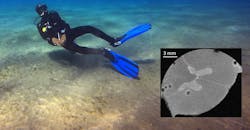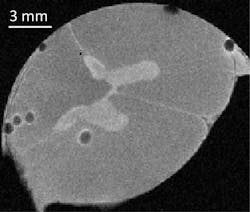Physicists Tackle Physiology to Determine the Cause of the Bends
When scuba divers stay down in the water too long, or at a depth below 33 ft, the nitrogen they breathe is under pressure, dissolved in the bloodstream and other tissues such as the spinal cord. When the diver ascends, that pressure is reduced and gas precipitates out of the tissues as bubbles.
When nitrogen bubbles in the spinal cord, it can be serious—a condition referred to as the bends. Divers can experience bladder dysfunction, sensory and motor issues, back pain, and numbness or tingling of the skin. These effects can last a month or longer, even with treatment.
For a long time, doctors believed these symptoms were caused by expanding bubbles of nitrogen compressing the spinal cord tissue. But Jens-Christian Meiners, a professor of physics and biophysics at the University of Michigan, had his doubts. If the symptoms were caused by nitrogen compressing the spinal cord, the standard treatment of decompression sickness—hyperbaric oxygen therapy, in which patients breathe oxygen in a pressurized room—should eliminate them. But hyperbaric oxygen is only partially effective, with 25% of patients still suffering symptoms a month or longer after the accident, according to Meiners.
With a $10,000 grant from Divers Alert Network, an organization devoted to scuba diving safety, Meiners looked into the causes of the bends. He and his team of students modelled the spinal cord fluid using gels injected with gas bubbles. The team then compressed and decompressed the gels to study how gas bubbles behaved inside them.
This MRI image shows decompression bubbles in a patient’s the spinal cord. The center shows the gray spinal cord material, surrounded by white spinal cord material where the bubbles preferentially form. The small black circles are nitrogen bubbles. (Courtesy: Jens-Christian Meiners)
“The first thing we noticed when we looked at these gels is that the bubbles were not forming like a balloon, like you would expect in an elastic medium,” Meiners says. “Instead, they were actually peeling and fracturing the gels.”
Meiners suspects that when a nucleated gas bubble (a bubble that grows by absorbing other bubbles) grows during and after the diver’s ascent, it tears the surrounding tissue. As the bubble continues to grow, the fracture spreads and further damages the nerve tissue.
In the current project, Meiners and his students will examine spinal cord tissue from cows. Placing the tissue in a pressure cell, they will compress the sample until it is under about six times as much air pressure as you experience at sea level and leave it pressurized for 48 hours. Then, they will subject it to a cycle of decompression and compression. Using a high-resolution magnetic resonance imaging machine, or MRI, they will observe how these gas bubbles form and create damage in the spinal cord.
“We think this may have implications for traumatic spinal cord injuries in general,” Meiners said. “The thought is that the high-pressure oxygen could help regenerate tissues. Our hypothesis is maybe there’s more to it: putting damaged tissue under pressure may be similar to compressing a wound and stitching it back together.”
The researchers’ work may present a new paradigm for how compression sickness affects tissues. Their findings may also lead to better approaches for treatment.


